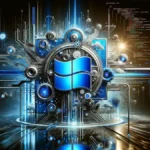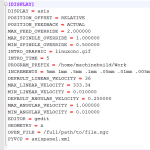We can define an Operating System, or simply OS, as a software program that serves as the interface between other applications and the hardware on a computer or mobile device.
Desktop operating systems perform basic tasks, such as recognizing input from a keyboard, sending output to a display screen, managing files and directories on a storage drive, and controlling peripheral devices like printers.

What is the Operating System?
The operating system (OS) is the underlying software that integrates the hardware with software applications. It is distinguished from the essential hardware components in that it consists entirely of software – millions of lines of machine commands that are understood and obeyed by the microprocessor.
The Operating System actually consists of hundreds or thousands of individual programs that bundled together. Many of these individual programs are designed to work cooperatively with each other. The OS is automatically executed each time the computer is started and it is the most important software component running on any computer. A modern computer cannot operate without an OS.
Although the CPU is frequently personified as the “brain”’ of the computer, it is really the Operating System software and the CPU acting together that provides the underlying ‘‘intelligence’’ of system. The OS and the CPU are inexorably linked; therefore, the distinction between the software and the hardware is sometimes blurred.
Operating System main tasks
The OS is designed to automatically manage nearly every task (or process) including maintenance of the files on the disk, tracking input from peripheral devices like keyboards or network cards, displaying output on printers and video displays and control of memory allocation. Memory allocation is crucial for maintaining stability of the system because if two programs try to use the same area of memory, both programs will usually fail. Two of the most critical jobs of the OS are ensuring that programs do not unintentionally interfere with each other and maintaining security.
A function paramount to the modern OS is the support of the graphical user interface (GUI). A GUI replaces typed computer commands with a graphical representation of the task (e.g., moving a file). This is accomplished by creating a visual representation of the computer file system (the desktop), icons, and windows and linking them to the movements of a pointing device such as a mouse.
The Operating System also provides a foundation or software platform for all other software (application programs). Therefore, the choice of OS, to a large extent, determines which application software can be used on a particular system.
Common operating systems
Common operating systems for desktop computers are Windows, macOS, and Linux. For mobile devices: Android and iOS are the most popular operating systems.
Drivers
An Operating System may consist of hundreds (or even thousands) of small programs called drivers. Drivers enable software to interact with the ubiquitous hardware devices attached to the motherboard and between components on the motherboard itself. In other instances, drivers allow one software component to safely interact with another piece of software.
Operating System from the user perspective
In conclusion, from the user perspective, the Operating System provides the framework that application software runs inside of. All application software runs on top of the OS that, in turn, is directly integrated to the hardware. In general, application software cannot interact directly with the hardware; it must work through the Operating System.
Today’s phones are also computers
Your smartphone is a computer, your smart TV is a computer, your game console, smart watches, even the latest home appliances are computers running an operating system.
Familiar desktop operating systems include Microsoft Windows, Apple macOS, Google’s Chrome OS, and Linux. The dominant smartphone operating systems are Apple’s iOS and Google’s Android.
Other devices, such as your Wi-Fi router, or GPS navigators may run “embedded operating systems.” These are specialized operating systems with fewer functions than a typical operating system, designed for more specific functions.
Is BIOS part of the Operating System?
If we accept the definition that Operating System is a piece of software designed to control the hardware of a specific equipment, we have to answer YES to that question. But I assure you that any answer would be controversial.

Basic input/output system (BIOS). BIOS is comprised of a non-erasable read only memory (ROM) chip that contains the minimal amount of software necessary to instruct the computer how to access the keyboard, mouse, display, disk drives, and communications ports.
When the power is first applied to the computer, the motherboard relies on the BIOS to tell what additional components are available to the motherboard for input and output (e.g., disk drives, memory, keyboard, etc.). The motherboard ‘‘becomes aware’’ of what is available and how to access it, each and every time the computer is restarted.
The BIOS also provides information to the motherboard on where to find the first piece of software to load during the startup process. The startup process is also known as the boot process. The first piece of software to load is usually a portion of the operating system that will coordinate the other software programs.
Operating Systems articles in the Network Encyclopedia
We have several articles available that describe the different types of actual and older Operating Systems.
- Introduction to BitLocker: The Digital VaultkeeperUnlock the secrets of BitLocker, Microsoft’s fortress for digital data. Discover how this powerful encryption tool locks down your information, ensuring that only you hold the key to your digital kingdom. From basic setup to in-depth security strategies, learn how BitLocker can protect your data from prying eyes and sneaky cyber thieves.
- UDF File System: 7 Surprising Aspects You Need to KnowExplore the intricacies of UDF Files in our comprehensive guide. Understand the key aspects of Universal Disk Format for optimal data storage. Essential reading for tech enthusiasts!
- Network Security Auditing in Windows EnvironmentsUncover the essentials of network security auditing in Windows environments, from audit policies to advanced tools and best practices.
- Linux Operating System Unveiled: The Power of the PenguinJoin us as we dive deep into the Linux Operating System, exploring its rise, robust architecture, and how it has reshaped the landscape of computing.
- Windows 1.0: Microsoft’s Bold Leap into GUIs [1985]Delve into the intriguing history of Windows 1.0, Microsoft’s first graphical user interface. Uncover the revolutionary features, hardware requirements, and the public’s reaction to this groundbreaking release in the mid-’80s.
- Windows RegistryLearn what Windows Registry is, how it works, and how to back up, edit and restore it.
- Understanding %systemroot% in Windows: A Comprehensive GuideSystemRoot is the directory where the core of Microsoft Windows operating systems files are stored.
- Environment Variables: Unveiling the Hidden Power in WindowsIn this article, we’ll dive deep into the world of Environment Variables, exploring their types, purposes, and the vital role they play in the smooth running of Windows OS.
- Management Information Format (MIF)Explore the pivotal role of Management Information Format (MIF) in simplifying device management in modern computing environments.
- INI FilesExplore the legacy of INI files in computing: their role in hardware, devices, and services configuration, and their evolution over time.
- BSD UNIXBSD UNIX stands for Berkeley Software Distribution UNIX, a version of UNIX that originated many common UNIX features such as the vi editor, C shell, and TCP/IP networking. BSD UNIX was developed in the 1970s at the University of California at Berkeley, which licensed the UNIX operating system from AT&T and then made a number of… Read more: BSD UNIX
- From Past to Present: Evolution of FAT32 Conversion UtilityAs we embark on this journey from the simple yet groundbreaking FAT32 Conversion Utility to today’s advanced tools, we delve into a narrative that is not just about bytes and systems, but about progress and the relentless march of technology.
- Windows 2000Windows 2000 was a Microsoft operating system built on NT Technology for use on personal computers, business desktops, laptops, and servers.
- Check Disk Utility: Chkdsk CommandThe transition from Scandisk to Chkdsk marks a pivotal advancement in disk diagnostics and repair. The Chkdsk (Check Disk) utility, integral to Windows 10 and Windows 11, embodies the essence of system resilience and data integrity.
- Secure Attention Sequence (SAS)At its core, SAS is a keystroke combination – Ctrl+Alt+Delete. When you press these keys simultaneously, you initiate a sequence that demands the highest level of attention from the operating system.
- OS/2: Tracing the Legacy of IBM’s Pioneering Operating SystemExplore the complete history of OS/2, from its inception with IBM and Microsoft to its lasting impact on modern operating systems.
- Understanding the Boot Process in Computers: From Power On to OS LoadingExplore the intricacies of the computer boot process, from BIOS roles to troubleshooting common boot issues.
- NDIS: Unveiling the Network Driver Interface SpecificationNetwork Driver Interface Specification, also known as NDIS, is a standard or specification that simplifies the process of writing drivers for network interface cards (NICs) and enables them to interact transparently with various transport protocols.
- LinuxLinux is an operating system derived from the UNIX family of operating systems that is POSIX-compliant and freely distributed through many sites on the Internet. Linux was developed in 1991 by a student from Finland named Linus Torvalds, who still controls the development of the Linux operating system kernel.
- Novell NetWare: The Pioneering Network Operating System of the 1980sNetWare was a network operating system from Novell that wass widely used in local area networks (LANs). NetWare was created by Novell in the early 1980s.



















